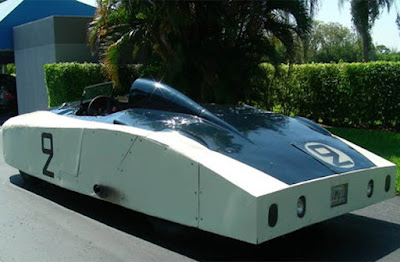New Long-tailed Beast - Pagani Automobili, the renowned Italian supercar manufacturer, has once again raised the bar with the introduction of its latest masterpiece – the Pagani Huayra R Evo. This exquisite creation is an enhanced version of the Huayra R lineup, featuring a distinctive open-top design, aptly termed a targa. Boasting a staggering maximum power output of 900 horsepower, Pagani claims that this new iteration surpasses the ferocity of its predecessor, the Huayra R track car, which made its debut in 2021.
 |
| The Pagani Huayra R Evo is an enhanced version of Huayra R featuring a distinctive design, aptly termed a targa. (Picture from: Autoblog) |
The genesis of the Huayra R Evo can be traced back to a moment of inspiration experienced by the visionary Horacio Pagani while watching a Formula Indy race in Nashville. A testament to meticulous craftsmanship, this marvel took approximately two years to complete, a timeframe justified by the manufacturer's pursuit of performance levels akin to the current Le Mans Prototype 2 race car.
 |
| The Pagani Huayra R Evo is a testament to meticulous craftsmanship that took around 2 years to complete. (Picture from: Autoblog) |
Pagani has not only pushed the boundaries of performance but has also incorporated notable improvements. The addition of a pop-out roof panel enhances aerodynamic downforce when removed, resulting in a remarkable 45% increase from the standard configuration. Impressively lightweight at 1,060 kg dry, the Huayra R Evo showcases Pagani's commitment to achieving the perfect balance of power and agility.
 |
| The genesis of the Pagani Huayra R Evo can be traced back to a moment of inspiration experienced by the visionary Horacio Pagani while watching a Formula Indy race in Nashville. (Picture from: Autoblog) |
The introduction of the "codalunga" (long tail) design element involves extending the front splitter by approximately four inches, seamlessly integrating and supporting the air intake for the cooling system. The rear end, now 7.5 inches longer, features a central stabilizer fin supporting the large rear wing, along with integrated struts. This meticulous redesign contributes to a substantial 45% increase in downforce. The open-top configuration further elevates total downforce by 5%, thanks to increased front and rear vertical loads.
 |
| The Pagani Huayra R Evo featuring with the "codalunga" (long tail) design element involves extending the front splitter by approximately four inches, seamlessly integrating and supporting the air intake for the cooling system. (Picture from: Autoblog) |
Under the hood, the Huayra R Evo houses the formidable V12 R-Evo engine – a naturally aspirated 6,000 cc V12 configuration. This powerhouse, enhanced with a redesigned intake manifold, new camshaft, and reconfigured exhaust system, delivers an awe-inspiring 900 horsepower and 567 pound-feet (770 Newton-meters) of torque. The bespoke six-speed sequential gearbox, a result of collaboration with HWA AG, weighs a mere 176 pounds.
 |
| The Pagani Huayra R Evo has 7.5 inches longer's rear end, coupled with a central stabilizer fin supporting the large rear wing, along with integrated struts. (Picture from: Autoblog) |
Ensuring a comfortable ride, the car features a forged aluminum alloy double-wishbone suspension, helical springs, and electronically controlled shock absorbers. The addition of a new heave damper further enhances controllability.
Braking prowess is provided by the CCM-R auto-ventilated carbon ceramic brakes and custom racing pads. Furthermore, the Huayra R Evo rides on 19-inch front and 20-inch rear rims, enveloped in Pirelli P Zero Slick tires (280/680 R19 at the front and 345/725 R20 at the rear).
 |
| Under the hood, the Pagani Huayra R Evo houses the formidable V12 R-Evo engine – a naturally aspirated 6,000 cc V12 configuration. (Picture from: Autoblog) |
Stepping inside the cabin, occupants are greeted by seats clad in fire-resistant material, equipped with six-point safety belts and carbon fiber headrests featuring special protection to mitigate serious injuries in case of an unfortunate incident. Pagani's commitment to global markets is evident as the Huayra can be configured with left or right-hand steering depending on the region. | uTiVEBUc49o |
 In conclusion, Pagani's Huayra R Evo stands as a testament to the brand's unwavering commitment to pushing the boundaries of automotive excellence. This masterpiece seamlessly combines cutting-edge technology, aerodynamic precision, and raw power, offering enthusiasts a driving experience like no other. The Huayra R Evo is not just a car; it's a symphony of engineering brilliance and artistic finesse, destined to leave an indelible mark in the world of high-performance automobiles. *** [EKA | FROM VARIOUS SOURCES | PAGANI AUTOMOBILI | ID.MOTOR1 | AUTOBLOG ]
In conclusion, Pagani's Huayra R Evo stands as a testament to the brand's unwavering commitment to pushing the boundaries of automotive excellence. This masterpiece seamlessly combines cutting-edge technology, aerodynamic precision, and raw power, offering enthusiasts a driving experience like no other. The Huayra R Evo is not just a car; it's a symphony of engineering brilliance and artistic finesse, destined to leave an indelible mark in the world of high-performance automobiles. *** [EKA | FROM VARIOUS SOURCES | PAGANI AUTOMOBILI | ID.MOTOR1 | AUTOBLOG ]Note: This blog can be accessed via your smart phone.




































